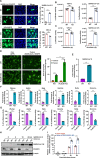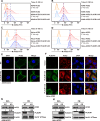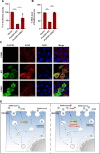PLSCR1 suppresses SARS-CoV-2 infection by downregulating cell surface ACE2
- PMID: 39945535
- PMCID: PMC11915802
- DOI: 10.1128/jvi.02085-24
PLSCR1 suppresses SARS-CoV-2 infection by downregulating cell surface ACE2
Abstract
Type I interferons exert their antiviral effects against SARS-CoV-2 by inducing the expression of interferon-stimulated genes (ISGs), including but not limited to LY6E, CH25H, IFITM2/3, and IFIH1. However, the antiviral effect and underlying mechanisms of action of most ISGs in SARS-CoV-2 infection are not yet fully understood. By screening 109 ISG-knockout cell lines, we identify that phospholipid scramblase 1 (PLSCR1), an interferon-inducible protein, acts as a crucial restriction factor against SARS-CoV-2 infection. Cells lacking PLSCR1 are highly susceptible to SARS-CoV-2 infection. Conversely, overexpression of PLSCR1 inhibits SARS-CoV-2 infection. Depletion of PLSCR1 enhances cellular entry of both pseudotyped and authentic SARS-CoV-2. Mechanistically, PLSCR1 inhibits SARS-CoV-2 entry by specifically downregulating plasma membrane expression of ACE2, the virus's receptor, without affecting the overall levels of ACE2 within the cell. As such, we unraveled previously unappreciated mechanisms by which PLSCR1 exerts its restrictive effect on SARS-CoV-2. These data provide new insights into the interplay between host innate antiviral immunity and SARS-CoV-2 and shed light on novel antiviral therapeutics.
Importance: Phospholipid scramblase 1 (PLSCR1) has been identified as a critical host restriction factor against SARS-CoV-2 infection. In this study, we demonstrated that PLSCR1 inhibited SARS-CoV-2 entry by downregulating the plasma membrane expression of ACE2, the primary receptor for viral entry. Our findings elucidate a novel host-pathogen interaction that not only deepens our understanding of the innate immune response to SARS-CoV-2 but offers potential strategies for therapeutic interventions against COVID-19.
Keywords: ACE2; PLSCR1; SARS-CoV-2.
Conflict of interest statement
The authors declare no conflict of interest.
Figures








Similar articles
-
The antiviral state of the cell: lessons from SARS-CoV-2.Curr Opin Immunol. 2024 Apr;87:102426. doi: 10.1016/j.coi.2024.102426. Epub 2024 May 24. Curr Opin Immunol. 2024. PMID: 38795501 Free PMC article. Review.
-
PLSCR1 is a cell-autonomous defence factor against SARS-CoV-2 infection.Nature. 2023 Jul;619(7971):819-827. doi: 10.1038/s41586-023-06322-y. Epub 2023 Jul 12. Nature. 2023. PMID: 37438530 Free PMC article.
-
Antiviral Activity of Type I, II, and III Interferons Counterbalances ACE2 Inducibility and Restricts SARS-CoV-2.mBio. 2020 Sep 10;11(5):e01928-20. doi: 10.1128/mBio.01928-20. mBio. 2020. PMID: 32913009 Free PMC article.
-
Tight junction protein LSR is a host defense factor against SARS-CoV-2 infection in the small intestine.EMBO J. 2024 Dec;43(23):6124-6151. doi: 10.1038/s44318-024-00281-4. Epub 2024 Oct 23. EMBO J. 2024. PMID: 39443717 Free PMC article.
-
Contributions of human ACE2 and TMPRSS2 in determining host-pathogen interaction of COVID-19.J Genet. 2021;100(1):12. doi: 10.1007/s12041-021-01262-w. J Genet. 2021. PMID: 33707363 Free PMC article. Review.
Cited by
-
Phospholipid scramblase 1: a frontline defense against viral infections.Front Cell Infect Microbiol. 2025 Apr 3;15:1573373. doi: 10.3389/fcimb.2025.1573373. eCollection 2025. Front Cell Infect Microbiol. 2025. PMID: 40248364 Free PMC article. Review.
-
UNC0638 inhibits SARS-CoV-2 entry by blocking cathepsin L maturation.J Virol. 2025 Jul 22;99(7):e0074125. doi: 10.1128/jvi.00741-25. Epub 2025 Jun 18. J Virol. 2025. PMID: 40530850 Free PMC article.
References
-
- Unali G, Crivicich G, Pagani I, Abou-Alezz M, Folchini F, Valeri E, Matafora V, Reisz JA, Giordano AMS, Cuccovillo I, Butta GM, Donnici L, D’Alessandro A, De Francesco R, Manganaro L, Cittaro D, Merelli I, Petrillo C, Bachi A, Vicenzi E, Kajaste-Rudnitski A. 2023. Interferon-inducible phospholipids govern IFITM3-dependent endosomal antiviral immunity. EMBO J 42:e112234. doi:10.15252/embj.2022112234 - DOI - PMC - PubMed
MeSH terms
Substances
Grants and funding
- NSFC82221004/The foundation for Innovative Research Group of the National Natural Science Foundation of China
- 82472255/MOST | National Natural Science Foundation of China (NSFC)
- 82102366/MOST | National Natural Science Foundation of China (NSFC)
- Double Innovation Plan of Jiansu province
- 2023-RC310-01/the Non-profit Central Research Institute Fund of the Chinese Academy of Medical Sciences
LinkOut - more resources
Full Text Sources
Medical
Research Materials
Miscellaneous

